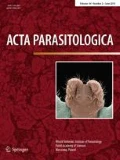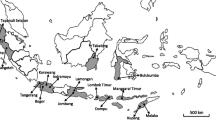Abstract
Purpose
Bovine babesiosis causes morbidity in tropical and subtropical countries worldwide. The present study aimed to determine the seroprevalence of Babesia bigemina and B. bovis in cattle and water buffaloes in Menoufia province, where the second-highest population of bovines in Lower Egypt are raised.
Materials and Methods
A total of 506 blood samples were collected from cattle (N = 262) and water buffaloes (N = 244) in Menoufia province, Egypt. Seroprevalences of B. bigemina and B. bovis in the samples were determined using recombinant Babesia antigen-specific enzyme-linked immunosorbent assays (ELISA).
Results
In cattle, the seroprevalences of B. bigemina and B. bovis were 41.60 and 38.17% (37.40 and 35.88% for IgM and 9.54 and 6.11% for IgG), respectively, whereas those of water buffaloes were 35.66 and 31.97% (27.87 and 21.72% for IgM and 15.16 and 15.16% for IgG), respectively. Statistically significant changes in the seroprevalences of the two infective agents were recorded on the basis of region and season of sample collection.
Conclusion
In conclusion, babesiosis is frequent and presents a threat of an epidemic among bovines in Menoufia province. In turn, control of bovine babesiosis is required because of its potential to detrimentally affect milk and meat production in Menoufia province.

Similar content being viewed by others
References
Bock R, Jackson L, De Vos A, Jorgensen W (2004) Babesiosis of cattle. Parasitology 129(1):S247–S269. https://doi.org/10.1017/S0031182004005190
Dantas-Torres F, Alves LC, Uilenberg G (2016) Babesiosis. In: Marcondes CB (ed) Arthropod borne diseases, 1st edn. Springer, Switzerland, pp 347–354. https://doi.org/10.1007/978-3-319-13884-8
Everitt JI, Shadduck JA, Steinkamp C, Clabaugh G (1986) Experimental Babesia bovisinfection in holstein calves. Vet Pathol 23:556–562. https://doi.org/10.1177/030098588602300503
Morzaria S, Katende J, Kairo A, Nene V, Musoke A (1992) New methods for the diagnosis of Babesia bigemina infection. Mem Inst Oswaldo Cruz 87(3):201–205. https://doi.org/10.1590/S0074-02761992000700033
de Vos AJ, Potgieter FT (1994) Bovine Babesiosis. In: Coetzer JAW, Thomson GR, Tustin RC (eds) Infectious diseases of livestock: with special reference to southern Africa, vol 2. Oxford University Press, Cape Town, South Africa, pp 278–294
Moody AH, Chiodini PL (2000) Methods for the detection of blood parasites. Clin Lab Haem 22:189–202
Mahoney DF, Ross DR (1972) Epizootiological factors in the control of bovine babesiosis. Aust Vet J 48:292–298. https://doi.org/10.1111/j.1751-0813.1972.tb05160.x
Mahoney DF (1975) The diagnosis of babesiosis in Australia. In: Wells EA (ed) Workshop on hemoparasites (anaplasmosis and babesiosis). Centro Internacional de Agricultura Tropical, Cali, Colombia, pp 49–62
Weiland G, Reiter I (1988) Methods for the measurement of serological response to Babesia. In: Ristic M (ed) Babesiosis of domestic animal and man. CRC Press Inc, Boca Raton, Florida, pp 143–158
Bose R, Jacobson RH, Gale KR, Waltisbuhl DJ, Wright IG (1990) An improved ELISA for the detection of antibodies against Babesia bovis using either a native or a recombinant B. bovis antigen. Parasitol Res 76:648–652. https://doi.org/10.1007/BF00931081
Araujo FR, Madruga CR, Leal CR, Schenk MA, Kessler RH, Marques AP, Lemaire DC (1998) Comparison between enzyme-linked immunosorbent assay, indirect fluorescent antibody and rapid conglutination test in detecting antibodies against Babesia bovis. Vet Parasitol 74:101–108. https://doi.org/10.1016/S0304-4017(97)00171-4
Ibrahim HM, Adjou Moumouni PF, Mohammed-Geba K, Sheir SK, Hashem IS, Cao S, Terkawi MA, Kamyingkird K, Nishikawa Y, Suzuki H, Xuan X (2013) Molecular and serological prevalence of Babesia bigemina and Babesia bovis in cattle and water buffalos under small-scale dairy farming in Beheira and Faiyum Provinces, Egypt. Vet Parasitol 198:187–192. https://doi.org/10.1016/j.vetpar.2013.08.028
Terkawi MA, Huyen NX, Shinuo C, Inpankaew T, Maklon K, Aboulaila M, Ueno A, Goo YK, Yokoyama N, Jittapalapong S, Xuan X, Igarashi I (2011) Molecular and serological prevalence of Babesia bovis and Babesia bigemina in water buffalo in the northeast region of Thailand. Vet Parasitol 178:201–207. https://doi.org/10.1016/j.vetpar.2011.01.041
Terkawi MA, Huyen NX, Wibowo PE, Seuseu FJ, Aboulaila M, Ueno A, Goo YK, Yokoyama N, Xuan X, Igarashi I (2011) Spherical body protein 4 is a new serological antigen for the global detection of Babesia bovis infection in cattle. Clin Vaccine Immunol 18:337–342. https://doi.org/10.1128/CVI.00388-10
Terkawi MA, Seuseu FJ, Eko-Wibowo P, Huyen NX, Minoda Y, Aboulaila M, Kawai S, Yokoyama N, Xuan X, Igarashi I (2011) Secretion of a new spherical body protein of Babesia bovis into the cytoplasm of infected erythrocytes. Mol Biochem Parasitol 178:40–45. https://doi.org/10.1016/j.molbiopara.2011.02.006
Guswanto A, Allamanda P, Mariamah ES, Sodirun S, Wibowo PE, Indrayani L, Nugroho RH, Wirata IK, Jannah N, Dias LP, Wirawan HP, Yanto R, Tuvshintulga B, Sivakumar T, Yokoyama N, Igarashi I (2017) Molecular and serological detection of bovine babesiosis in Indonesia. Parasit Vectors 10:550. https://doi.org/10.1186/s13071-017-2502-0
Abdel-Shafy S, Mahmoud MS (2002) Morphological and ultrastructural studies on Babesia bigemina local strain in haemolymph and salivary glands of infected Boophilus annulatus females. J Egypt Vet Med Assoc 62:247–256
Adham FK, Abd-el-Samie EM, Gabre RM, El-Hussein H (2009) Detection of tick blood parasites in Egypt using PCR assay I-Babesia bovis and Babesia bigemina. Parasitol Res 105:721–730. https://doi.org/10.1007/s00436-009-1443-8
Mahmmod YS (2012) Molecular detection of natural Babesia bovis infection from clinically infected and apparently healthy water buffaloes (Bubalis bubalis) and crossbred cattle. J Buffalo Sci 1:55–60. https://doi.org/10.6000/1927-520X.2012.01.01.10
Nayel M, El-Dakhly KM, Aboulaila M, Elsify A, Hassan H, Ibrahim E, Salama A, Yanai T (2012) The use of different diagnostic tools for Babesia and Theileria parasites in cattle in Menofia, Egypt. Parasitol Res 111:1019–1024. https://doi.org/10.1007/s00436-012-2926-6
Elsify A, Sivakumar T, Nayel M, Salama A, Elkhtam A, Rizk M, Mosaab O, Sultan K, Elsayed S, Igarashi I, Yokoyama N (2015) An epidemiological survey of bovine Babesia and Theileria parasites in cattle, buffaloes, and sheep in Egypt. Parasitol Int 64:79–85. https://doi.org/10.1016/j.parint.2014.10.002
Mahmoud MS, Kandil OM, Nasr SM, Hendawy SH, Habeeb SM, Mabrouk DM, Silva MG, Suarez CE (2015) Serological and molecular diagnostic surveys combined with examining hematological profiles suggests increased levels of infection and hematological response of cattle to babesiosis infections compared to native buffaloes in Egypt. Parasit Vectors 8:319. https://doi.org/10.1186/s13071-015-0928-9
Africa Sustainable Livestock 2050 (2018) Livestock production systems spotlight- Egypt cattle and buffaloes, and poultry sectors. Food and Agriculture Organization, Rome, Italy
Sergeant ESG (2018). Epitools epidemiological calculators. Ausvet. http://epitools.ausvet.com.au
Food and Agriculture Organization of the United Nations (2019). FAOSTAT statistical database. http://faostat.fao.org/
Levy MG, Rustic M (1980) Babesia bovis: continuous cultivation in a microaerophilus stationary phase culture. Science 204:1218–1220. https://doi.org/10.1126/science.7355284
Fereig RM, Mohamed SGA, Mahmoud HYAH, AbouLaila MR, Guswanto A, Nguyen TT, Mohamed AE, Inoue N, Igarashi I, Nishikawa Y (2017) Seroprevalence of Babesia bovis, B. bigemina, Trypanosoma evansi, and Anaplasma marginale antibodies in cattle in southern Egypt. Ticks Tick Borne Dis 8:125–131. https://doi.org/10.1016/j.ttbdis.2016.10.008
El-Dakhly KM, Arafa WM, Soliman S, Abdel-Fatah OR, Wahba AA, Esteve-Gasent MD, Holman PJ (2020) Molecular detection, phylogenetic analysis, and genetic diversity of Theileria annulata, Babesia bigemina, and Anaplasma marginale in cattle in three districts of Egypt. Acta Parasitol. https://doi.org/10.2478/s11686-020-00189-z
McCosker PJ (1981) The global importance of babesiosis. In: Ristic M, Krier JP (eds) Babesiosis. Academic Press, New York, pp 1–24
World Organization for Animal Health (2008) OIE manual of diagnostic tests and vaccines. Office International des Epizooties. https://www.oie.int/doc/ged/D7710.PDF. Accessed 1 Jun 2020
Ica A, Vatansever Z, Yildirim A, Duzlu O, Inci A (2007) Detection of Theileria and Babesia species in ticks collected from cattle. Vet Parasitol 148:156–160. https://doi.org/10.1016/j.vetpar.2007.06.003
Applewhaite LM, Craig TM, Wagner GG (1981) Serological prevalence of bovine babesiosis in Guyana. Trop Anim Health Prod 13:13–18. https://doi.org/10.1007/BF02237880
Sukanto IP, Payne RC, Partoutomo S (1993) Bovine babesiosis in Indonesia. Prev Vet Med 16:151–156. https://doi.org/10.1016/0167-5877(93)90085-8
Terkawi MA, Alhasan H, Huyen NX, Sabagh A, Awier K, Cao S, Goo YK, Aboge G, Yokoyama N, Nishikawa Y, Kalb-Allouz AK, Tabbaa D, Igarashi I, Xuan X (2012) Molecular and serological prevalence of Babesia bovis and Babesia bigemina in cattle from central region of Syria. Vet Parasitol 187:307–311. https://doi.org/10.1016/j.vetpar.2011.12.038
Abdo Rizk M, Salama A, El-Sayed SA, Elsify A, El-Ashkar M, Ibrahim H, Youssef M, El-Khodery S (2017) Animal level risk factors associated with Babesia and Theileria infections in cattle in Egypt. Acta Parasitol 62:796–804. https://doi.org/10.1515/ap-2017-0096
Tembue AAM, Silva FJM, Silva JB, Santos TM, Santos HA, Soares CO, Fonseca AH (2011) Risk factors associated with the frequency of antibodies against Babesia bovis and Babesia bigemina in cattle in southern Mozambique. Pesq Vet Bras 31:663–666. https://doi.org/10.1590/S0100-736X2011000800005
Vieira LL, Canever MF, Cardozo LL, Cardoso CP, Herkenhoff ME, Neto AT, Vogel CIG, Miletti LC (2019) Prevalence of Anaplasma marginale, Babesia bovis, and Babesia bigemina in cattle in the Campos de Lages region, Santa Catarina state, Brazil, estimated by multiplex-PCR. Parasite Epidemiol Control 6:e00114. https://doi.org/10.1016/j.parepi.2019.e00114
Asmaa NM, ElBably MA, Shokier KA (2014) Studies on prevalence, risk indicators and control options for tick infestation in ruminants. Beni-Suef Univ J Basic Appl Sci 3:68–73. https://doi.org/10.1016/j.bjbas.2014.02.009
Khan MN, Hayat CS, Iqbal Z, Hayat B, Naseem A (1993) Prevalence of ticks on livestock in Faisalabad. Pak Vet J 13:182e4
Acknowledgements
We are grateful to the veterinarians for their help and kind assistance in collecting and preparing the field samples. This study was supported by Grant-in-Aid for Scientific Research (18kk0188) from Ministry of Education, Culture, Sports, Science, and Technology, Japan, and the Japanese Society for the Promotion of Science Core-to-Core Program.
Author information
Authors and Affiliations
Contributions
Conceptualization and design of the study: HMI and XX. Sample collection: HMI and NMB. Laboratory assays: HMI, HMA, DSM, KM-G, SKS and AG-K. Data analysis: HMI and EMG. Drafting of the manuscript: HMI, EMG and MAT. Editing and revising: HMI, EMG, MAT, BB, LM and XX. All authors approved the final version of the manuscript.
Corresponding authors
Ethics declarations
Conflict of interest
None of the authors of this work has a financial or personal relationship with other people or organizations that could inappropriately influence or bias the content of the paper.
Ethical approval
Sampling in the public markets in Menoufia was permitted by the local administrators of the market. The purpose and procedures involved in the present study were explained and informed consent from all farmers was obtained prior to blood sample collection of their animals. All field sampling and laboratory procedures were carried out according to the ethical guidelines for use of animal samples of Obihiro University of Agriculture and Veterinary Medicine, Hokkaido, Japan (Permit for animal experiment: 19-15) and the Institutional Animal Ethical Committee, Menoufia University, Egypt (approval ID: MUFS/F/IM/2/17).
Additional information
Publisher's Note
Springer Nature remains neutral with regard to jurisdictional claims in published maps and institutional affiliations.
Rights and permissions
About this article
Cite this article
Ibrahim, H.M., Galon, E.M.S., Tumwebaze, M.A. et al. Serological Survey of Babesia bigemina and Babesia bovis in Cattle and Water Buffaloes from Menoufia Province, Egypt. Acta Parasit. 66, 1458–1465 (2021). https://doi.org/10.1007/s11686-021-00338-y
Received:
Accepted:
Published:
Issue Date:
DOI: https://doi.org/10.1007/s11686-021-00338-y




